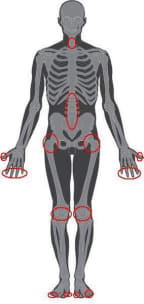By Alison Ballance
“It’s wonderful as a clinical researcher to see the fruits of your research translated into practise. That’s the most wonderful thing – and unfortunately it’s kind of rare in clinical research.” Haxby Abbott, Department of Surgical Sciences, Dunedin School of Medicine, University of Otago.

Osteoarthritis can occur in a number of joints, and mobility can be impaired when it occurs in the hips, knees and ankles. Photo: Wikimedia Commons / Milorad Dimic MD CC BY-SA 3.0
Haxby Abbott is a physiotherapist interested in managing musculoskeletal conditions, such as osteoarthritis, through exercise and manual therapy rather than drugs or surgery. In mid-2012 his research led to the creation of the Joint Clinic at Dunedin Hospital.
“We set up the Joint Clinic, which is a multi-way pun,” says Haxby. “Hip and knee joints. Also a joint effort between physiotherapy and orthopaedic surgeons, and a joint effort between the University of Otago and the District Health Board.”
The Joint Clinic began when then-GP Liaison Officer for Dunedin Hospital, Anne Worsnop, heard Haxby give a seminar about the MOA or Management of Osteoarthritis Trial. In the MOA trial 206 participants were divided into four groups: usual GP care plus exercise therapy, usual GP care plus manual therapy, usual care plus manual and exercise therapy, and just usual care. The patients were followed up over five years.
“The results have been very good, and both exercise therapy and manual therapy provided significant benefit over and above usual care from a GP,” says Haxby. “Manual therapy had a stronger effect for both the economic evaluation, as well as the clinical pain and dysfunction measures. Exercise therapy had a stronger effect in terms of the physical performance measures, so the patient’s ability to get up from a chair, walk quickly across the room, turn around and walk back again, to step up and down stairs – those physical strength and agility and performance measures were stronger in the exercise therapy group. And, interestingly, quality adjusted life years.”
The MOA trial led to another trial, carried out in both the United States and New Zealand, which looked further at the effect of combined manual and exercise therapy. The results from the New Zealand participants showed a clear benefit, and it was this, along with a strong economic evaluation of the effectiveness of the two therapies in managing osteoarthritis, that led to the creation of the Joint. Clinic.
What Anne Warsnop had identified was a gap in available treatment at Dunedin Hospital. Patients with severe hip and knee osteoarthritis were being sent to the hospital by their GPs to be assessed for possible joint replacement surgery. However, a lack of orthopaedic consultations meant 40% of these people were being sent back to their GP without seeing an orthopaedic surgeon.
Now, these patients are referred to the Joint Clinic, where they are assessed by an orthopaedic nurse and a physiotherapist who take a ‘whole of life’ approach. Medications and diet are reviewed, aids such as walking sticks supplied as necessary, and then the patient is referred to the physiotherapy department at the hospital for a course of exercise and manual therapy. After 8 weeks of this the patients are sent back to their GP, but with an ongoing exercise prescription. If necessary, the Joint Clinic staff can refer people on to an orthopaedic surgeon.
Haxby Abbott is currently reviewing the effectiveness of the Joint Clinic, but patient Sybil Kirkwood is more than happy with the results. Her osteoarthritis was making it difficult to maintain her fitness following a triple heart bypass, and it was also preventing her from playing her favourite sport, lawn bowls. The Joint Clinic provided her a stick to help her balance, and the exercise class has helped with her balance, coordination and strength. Sybil says the main thing is that she is now more confident about walking, and she’s looking forward to getting back to playing bowls.
In 2014 Haxby Abbott was co-recipient of the University of Otago’s Carl Smith Medal and Rowheath Trust Award. In 2012 he received a University of Otago Early-Career Award for Distinction in Research.

